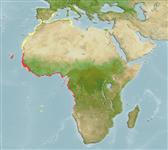Scomberomorus tritor (Cuvier, 1832)
West African Spanish mackerel
Waarneming toevoegen in Fish Watcher
| Native range | All suitable habitat | Point map | Year 2050 |

|
| This map was computer-generated and has not yet been reviewed. |
| Scomberomorus tritor AquaMaps Data sources: GBIF OBIS |
Uploaden van uw Foto's en video's
Pictures | Google afbeeldingScomberomorus tritor
Picture by JJPhoto
Pictures | Google afbeeldingScomberomorus tritor
Picture by JJPhoto
Common names from other countries
Classificatie / Names Lokale namen | Synoniemen | Catalog of Fishes(Genus, Soort(en)) | ITIS | CoL | WoRMS | Cloffa
> Scombriformes (Mackerels) > Scombridae (Mackerels, tunas, bonitos) > Scombrinae
Etymology: Scomberomorus: Latin, scomber = mackerel + Greek, moros = silly, stupid (Ref. 45335).
More on author: Cuvier.
Etymology: Scomberomorus: Latin, scomber = mackerel + Greek, moros = silly, stupid (Ref. 45335).
More on author: Cuvier.
Environment: milieu / climate zone / depth range / distribution range Ecologie
marien; brak water; oceanodroom (Ref. 51243); diepte 1 - 40 m (Ref. 28173), usually 20 - 25 m (Ref. 28173). Tropical; 45°N - 19°S, 24°W - 14°E (Ref. 168)
Verspreiding Landen | FAO regio's | Ecosystemen | Voorkomen | Point map | Introducties | Faunafri
Eastern Atlantic: Canary Islands and Senegal to the Gulf of Guinea and Baía dos Tigres, Angola. Rarely found in the northern Mediterranean Sea, along the coasts of France and Italy. This species has been erroneously been considered as a synonym of Scomberomorus maculatus by many authors.
Lengte bij maturiteit / Grootte / Gewicht / Leeftijd
Maturity: Lm 37.3, range 33 - 45 cm
Max length : 100.0 cm TL mannelijk / geslacht onbekend; (Ref. 2683); 98.0 cm FL (female); common length : 75.0 cm TL mannelijk / geslacht onbekend; (Ref. 2683); max. gepubliceerd gewicht: 6.0 kg (Ref. 40637); max. gerapporteerde leeftijd: 5 Jaren (Ref. 27160)
Max length : 100.0 cm TL mannelijk / geslacht onbekend; (Ref. 2683); 98.0 cm FL (female); common length : 75.0 cm TL mannelijk / geslacht onbekend; (Ref. 2683); max. gepubliceerd gewicht: 6.0 kg (Ref. 40637); max. gerapporteerde leeftijd: 5 Jaren (Ref. 27160)
Korte beschrijving Determinatiesleutels | Morfologie | Morfometrie
Dorsale stekels (totaal) : 15 - 18; Dorsale zachte stralen (totaal) : 0; Anale zachte stralen: 17 - 20; Wervels: 46 - 47. Interpelvic process small and bifid. Body covered with small scales. Lateral line gradually curving down toward caudal peduncle. Intestine with 2 folds and 3 limbs. Swim bladder absent. Some large individuals with thin vertical bars. Anterior half of first dorsal fin and margin of posterior half of first fin black.
Inhabits warm waters (Ref. 2683). Forms school close to the shore (Ref. 9987). Enters coastal lagoons and feeds on clupeids particularly Ethmalosa fimbriata. Reproduces in July to August (Ref. 5377). Eggs and larvae are pelagic (Ref. 6769). Utilized fresh, dried-salted, smoked and frozen (Ref. 9987).
Levenscyclus en paargedrag Maturiteit | Voortplanting | Paaien | Eieren | Fecunditeit | Larven
Hoofdreferentie
Upload your references | Referenties | Coördinator : Collette, Bruce B. | Medewerkers
Collette, B.B. and C.E. Nauen, 1983. FAO Species Catalogue. Vol. 2. Scombrids of the world. An annotated and illustrated catalogue of tunas, mackerels, bonitos and related species known to date. Rome: FAO. FAO Fish. Synop. 125(2):137 p. (Ref. 168)
Status op de Rode Lijst van het IUCN (Ref. 130435: Version 2024-2)
Niet bedreigd (LC) ; Date assessed: 01 June 2022
Gevaar voor de mens
Harmless
Gebruik door de mens
Visserij: commercieel; sportvis: ja
FAO(visserij: productie; publication : search) | FishSource | Sea Around Us
Meer informatie
Population dynamics
Groeiparameters
Max. ages / sizes
Length-weight rel.
Length-length rel.
Lengtefrequenties
Massaconversie
Rekrutering
Abundantie
Groeiparameters
Max. ages / sizes
Length-weight rel.
Length-length rel.
Lengtefrequenties
Massaconversie
Rekrutering
Abundantie
Life cycle
Voortplanting
Maturiteit
Fecunditeit
Paaien
Spawning aggregations
Eieren
Ontwikkeling van de eieren
Larven
Larvale populatiedynamiek
Voortplanting
Maturiteit
Fecunditeit
Paaien
Spawning aggregations
Eieren
Ontwikkeling van de eieren
Larven
Larvale populatiedynamiek
Anatomy
Kieuwoppervlak
Brain
Otolith
Kieuwoppervlak
Brain
Otolith
Physiology
Body composition
Nutrients
Zuurstofverbruik
Zwemtype
Zwemsnelheid
Visual pigments
Fish sound
Diseases & Parasites
Toxicity (LC50s)
Body composition
Nutrients
Zuurstofverbruik
Zwemtype
Zwemsnelheid
Visual pigments
Fish sound
Diseases & Parasites
Toxicity (LC50s)
Genetics
Genetica
Heterozygosity
Erfelijkheid
Genetica
Heterozygosity
Erfelijkheid
Human related
Aquaculture systems
Aquacultuurprofielen
Kweeklijnen
Ciguatera cases
Stamps, coins, misc.
Aquaculture systems
Aquacultuurprofielen
Kweeklijnen
Ciguatera cases
Stamps, coins, misc.
Tools
E-boek | Veldgids | Lengtefrequentie Tool | Levenscyclus tool | Verspreidingskaart | Classification Tree
| Catch-MSY |
Speciale rapporten
Bekijk gegevens voor het houden in een aquarium | Bekijk Fact Sheets voor de soort | Bekijk Aquacultuur Fact Sheets
Download XML
Internetbronnen
Aquatic Commons | BHL | Cloffa | Websites from users | Bekijk FishWatcher | CISTI | Catalog of Fishes(Genus, Soort(en)) | DiscoverLife | ECOTOX | Faunafri | Fishtrace | GenBank(genoom, nucleotide) | GloBI | GOBASE | | Google Books | Google Scholar | Google | IGFA World Record | MitoFish | Nationale databanken | Otolith Atlas of Taiwan Fishes | PubMed | Reef Life Survey | Scirus | SeaLifeBase | Tree of Life | Wikipedia(ga naar, zoek) | World Records Freshwater Fishing | Zoological Record
Estimates based on models
Preferred temperature (Ref. 115969): 22.7 - 27.7, mean 25.9 (based on 10 cells).
Fylogenetische diversiteitsindex (Ref. 82804): PD50 = 0.5000 [Uniqueness, from 0.5 = low to 2.0 = high].
Bayesian length-weight: a=0.00832 (0.00511 - 0.01354), b=3.02 (2.89 - 3.15), in cm Total Length, based on LWR estimates for this species & Genus-body shape (Ref. 93245).
Trofisch niveau (Ref. 69278): 4.4 ±0.8 se; based on diet studies.
Weerstandsvermogen (Ref. 120179): Gemiddeld, minimale populatieverdubbelingstijd 1,4-4,4 jaar (K=0.31-0.33; tmax=5; Fec=1 million).
Prior r = 0.39, 95% CL = 0.26 - 0.59, Based on 1 data-limited stock assessment.
Fishing Vulnerability (Ref. 59153): Moderate vulnerability (38 of 100).
Climate Vulnerability (Ref. 125649): High vulnerability (60 of 100).




